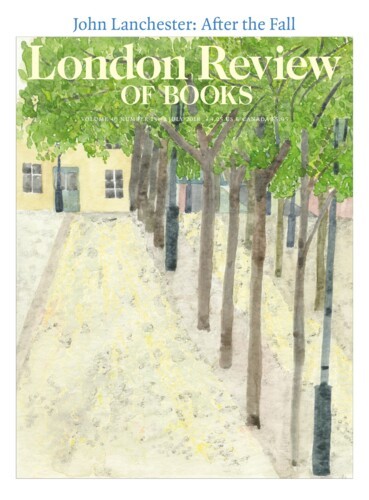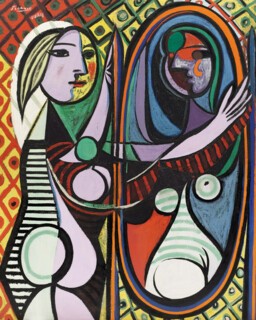Picasso turned fifty in October 1931. The following year he began compiling his catalogue raisonnée, a highly unusual activity for a living artist. In June 1932 his first retrospective was held at the Galeries Georges Petit in Paris; Picasso selected and hung the works himself. Determined to challenge the critics who claimed that his best work was behind him, Picasso ignored chronology, placing paintings that were scarcely dry alongside masterpieces from early in his career, with no dates, titles or supporting information. A room dedicated to this retrospective is at the centre of the exhibition Picasso 1932 at Tate Modern (until 9 September), a show that takes literally Picasso’s statement that ‘the work that one does is a way of keeping a diary’, giving a day by day, month by month examination of the year. The accompanying catalogue includes a chronology detailing where Picasso was and who he was with for 366 days (it was a leap year): a list of social engagements and erotic arrangements that is surely not the kind of ‘diary’ Picasso had in mind. Instead he hoped his work would serve as evidence of the parallel, artistic life that unfolded in the studio, the workings of which were as mysterious to him as to anyone else.
The justification for this survey of a single year is made in a nod to Picasso’s biographer, John Richardson, who described 1931-32 as his annus mirabilis. It was a hugely productive year, in part because of the new work Picasso was creating for the retrospective, in part, it’s claimed, because of his relationship with the 22-year-old Marie-Thérèse Walter, whom he had met in 1927. She serves as probable model or muse for many of the images of women among the 120 paintings at Tate – there are also sculptures, photographs and documents – and is recognisable by her blonde hair and strong nose. Certain preoccupations recur across the year, most notably different treatments of the female form: the furious, needle-toothed harpy in The Woman with a Dagger, Picasso’s reimagining of David’s The Death of Marat; serene classical busts with engorged, proboscis-like noses in the sculptures produced at his studio at Boisgeloup; disembodied assemblages of abstract volumes, floating in space; languorous, reclining odalisques, lost in sleep or contemplation. Many of the paintings demonstrate a new, exuberant use of colour; others, such as the full-size charcoal drawings on canvas, rely entirely and thrillingly on line – a formidable display of draughtsmanship.
The exhibition’s narrow focus allows us to see the speed with which each approach informed the next. In The Reading, the sinuous form of a young woman is interwoven with that of the chair that supports her, her head thrown back and eyes closed as the book on her lap lies unread. It was followed four days later by The Yellow Belt, in which a monstrous form with raised snout, boneless, paw-like arms and a red slash for a mouth gazes out at us from the same chair. Both figures have elements of Marie-Thérèse, though it’s not clear how much they actually saw of each other in 1932. Sometimes tenderness and vulgarity combine in a single image. In The Dream, a young woman is shown asleep in a red armchair, her head tilted sideways, one breast exposed, her hands gathered at her crotch. Bright colours shimmer against a background of domestic wallpaper and panelling. A black line that defines one of the planks in the wall extends to bisect the woman’s face, its two halves connected only by her red lips. The lower half is a pale green crescent, framed by a cascade of blonde hair; the upper section, coloured the same pale purple as her body, is unmistakeably the shape of an erect penis.
In limiting themselves to a single year the curators have inevitably introduced some bathetic moments – see the Sunday painter-style landscapes of Boisgeloup in the rain – but much of what is on show at Picasso 1932 still vibrates with the frenetic energy of its creation. As always, we find Picasso engaged in a struggle with his artistic rivals, both contemporaries and old masters. In 1931 he had visited Matisse’s retrospective at the Galeries Georges Petit, and the impact of Matisse’s work is evident in Picasso’s embrace of vibrant, tropical colour; also perhaps in his decision (unlike Matisse) to hang the retrospective himself. Along one wall of the fourth room at Tate are three extraordinary, large-scale paintings borrowed from private collections. All are studies of naked women, or the same naked woman, asleep. In the first, Nude, Green Leaves and Bust, painted on a single day in March, a classical bust on a pedestal surveys the pale mauve form of the sleeping woman (sculpted heads in Picasso’s paintings of this period rarely appear inanimate); her body is partially wrapped in mysterious black bands. The woman’s profile is exactly the same as that of the bust, but inverted: artwork mirroring its inspiration. The heavy blue drapes that block out the light here are thrown open in Nude in a Black Armchair, completed two days later on 10 March. A vivid sunset explodes outside the window, illuminating the exquisite tones of the woman’s hair, while the rest of her body is delineated in a few bold strokes. The Mirror provides the ultimate voyeuristic fantasy: the model rolls towards the viewer, a view of her behind caught in a looking glass. The bodies in these paintings, despite their simplicity, have an unprecedented sensuality. Picasso’s usually reticent dealer, Daniel-Henry Kahnweiler, said that they seemed to have been painted by a satyr or a giant rather than a human being; they left him ‘écrasé’ – ‘stunned’. Turning from these images the viewer is confronted by the firework display of MoMA’s Girl before a Mirror, in which the model contemplates her own, multicoloured body in the glass – image and reflection, subject and viewer all in dialogue with one another.
Entering the room dedicated to the 1932 retrospective we leave the brightly lit, contemporary gallery for a space in which crimson walls evoke the 19th-century grandeur of the Galeries Georges Petit. It’s a relief to escape the focus of a single year, and see Picasso’s career as he himself saw it, a continually evolving whole. One wall re-creates a section of the hang exactly as he arranged it in 1932. The bearded, pale, emaciated young artist in a self-portrait of 1901 looks down on a selection of portraits of his family: his future wife, the Russian ballerina Olga Khokhlova, in a painting from 1917, surrounded by images of their son, Paul, from the 1920s. On the opposite wall, three works hung together testify to the journey the brooding young man in the self-portrait made in the ensuing three decades. Tate’s Girl in a Chemise from 1905, so familiar through endless reproduction, glows against the dark background, the energy of its subtle tones restored. The neighbouring work, Seated Nude (1909), shatters the female form into a multitude of planes, before they are reassembled in the bold, black outlines and gaudy colouration of Sleeping Woman by a Mirror from 1932. The Three Dancers leap in Bacchic frenzy next to the life-size welded metal sculpture Woman in the Garden. In the early 1930s it was still Picasso’s Cubist works that were fetching the highest prices at auction – a source of considerable frustration to him – but in curating his own work he tried to ensure that visitors would see an extended exploration of themes and subjects, transcending movements and dates. Archival photographs confirm the number of works from 1932 that were included: 18 paintings from the first four months of the year. They range from beauty to ugliness, joie de vivre to terror. Some show figures gambolling on the beach; others show a female bather being lifted near death from the water. Picasso was absent on the opening night: his nerves were understandable. Visitors to the Galeries Georges Petit would, Brassaï said, ‘at a single glance … take in … the sum total of his existence’.
Send Letters To:
The Editor
London Review of Books,
28 Little Russell Street
London, WC1A 2HN
letters@lrb.co.uk
Please include name, address, and a telephone number.


